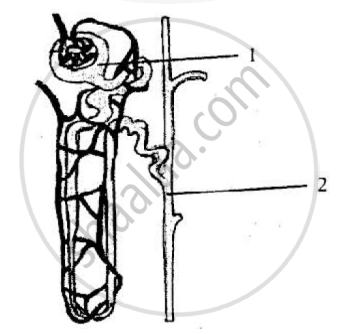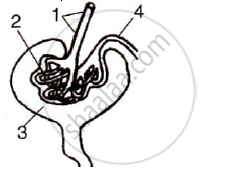Advertisements
Advertisements
Question
The organs A of a person have been damaged completely due to which too much of a poisonous waste material B has started accumulating in his blood, making it dirty. In order to save this person's life, the blood from an artery in the person's arm is made to flow into long tubes made of substance E which are kept in coiled form in a tank containing solution F. This solution contains three materials G, H and I in similar proportions to those in normal blood. As the person's blood passes through long tubes of substance E, most of the wastes present in it go into solution. The clean blood is then put back into a vein in the arm of the person for circulation.
(a) What are organs A?
(b) Name the waste substance B.
(c) What are (i) E, and (ii) F?
(d) Name G, H and I.
(e) What is the process described above known as?
Solution
(a) Organ A is kidney. Complete damage of the kidney (organ A) can lead to the accumulation of waste material B, i.e. urea, in the blood.
(b) The waste substance B is urea.
(c)
(i) In dialysis, the blood from a convenient artery is pumped into the dialyser of a dialysing machine. The dialyser contains a coiled cellophane tube made of substance E, called cellulose. It is surrounded by the dialysing solution (F). Hence, E represents cellulose.
(ii) F represents the dialysing solution.
(d) The dialysing solution contains water (G), glucose (H) and salts (I), which is similar in concentration to those in normal blood.
(e) The process of removing waste substances like urea from the blood using a kidney machine is known as dialysis.
APPEARS IN
RELATED QUESTIONS
Draw a diagram of the human excretory system and label the various parts.
State the exact location of the Loop of Henle.
Identify the odd one.
The diagram given below is that of a structure present in a human kidney.
Study the same and answer the questions that follow:

1) Name the structure represented in the diagram
2) What is the liquid entering part ‘1’ called?
Name two substances present in this liquid that are reabsorbed in the tubule.
3) What is the fluid that comes to part ‘2’ called?
Name the main nitrogenous waste in it.
4) Mention the three main steps involved in the formation of the fluid mentioned in (iii) above
5) Name the substance which may be present in the fluid in part ‘2’ if a person suffers from Diabetes mellitus.
What gaseous waste products are excreted by plants?
Where is the dirty blood in our body filtered?
In summer the urine is slightly thicker than in winter explain the reason.
Differentiate between the following pairs of term :
Renal cortex and renal medulla
Study the diagram given alongside and then answer the question that follow:
Name the region in the kidney where the above structure is present?

Explain the difference between the excretory system of humans and plants.
Choose the odd one out in the following series:
Proximal convoluted duct, loop of Henle, vein.
Complete the following sentence with appropriate word:
______ is the functional unit of kidney.
Choose the Odd One Out:
Hypotonic filtrate is formed in _______.
Answer the following question.
Name any one guanotelic organism.
Answer the following question.
State the role of liver in urea production.
The mode of excretion of nitrogenous wastes like ammonia which takes place by simple diffusion is called ______.
Name the following:
The main nitrogenous waste formed in the body.
Give two examples of the following:
Nitrogenous waste
